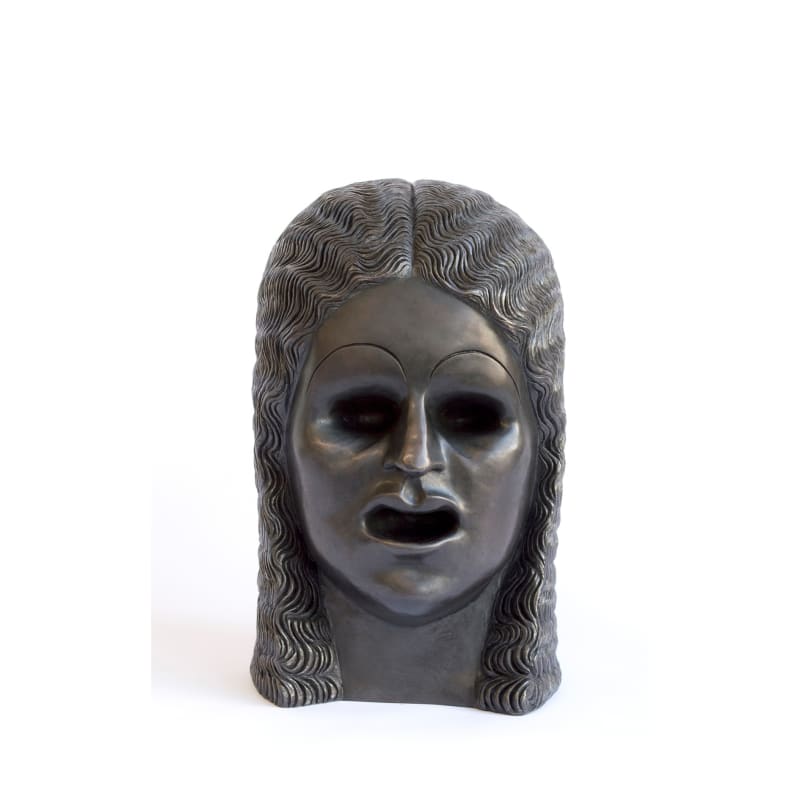In the mythological tales of ancient Greece, the power of a “seer” was her ability to see through time—both a blessing and a curse. The visions oracles gave to the community came at a cost. Ostracized or mocked as madwomen, seers could never comfortably inhabit the present. Cassandra, who infamously prophesized the fall of Troy, was cursed to be perpetually dismissed and enslaved when her proclamation came true; Tiresias, who lived as both a man and a woman, was later struck blind by Juno for siding with Jupiter. To see too much was to be unstable: living between the past and the future, between transcendent sight and blindness.
A similar slippage of time and sight occurs in the work of Brooklyn-based artist Sarah Peters. As sculpture, the work flickers between multiple eras—at once ancient, modernist, and hyper-postmodern. With her recent pieces in bronze—the subject of a small exhibition at Eleven Rivington—Peters marvelously adopts the stylized stateliness of ancient Mediterranean statuary. Her cast, life-size heads carry delicately groomed hair atop elegantly structured faces, and though eyes are left as cavities, each head somehow maintains the clear, forthright gaze of an emperor or goddess. The bronze busts could fit within the Roman sculpture court of the Metropolitan Museum, or, with their chic beards and tinge of disaffection, at a coffee shop on Bedford Avenue.
The academic bust is a staple in Peters’s practice, a rich foundation from which she continues to spin idiosyncratic twists of form. Unlike Greco-Roman portraiture or American neoclassicism—art historical periods which clearly enthrall the artist—these sculptures do not reference specific historical leaders. Rather, each bust adopts the generic, aristocratic posture historically reserved for men of influence (say, Augustus or George Washington), then quietly subverts.
Take “Portrait of a Bearded Man with Triangular Base” (2015), an older, philosopher-type, balding with a long, stratified and symmetrical beard. Seen in profile, the angular force of the beard thrusts the head forward and echoes the force of the futurist sculptures of Umberto Boccioni. Instead of machine-like arms and legs projecting the body into space, he’s all beard, and the energy seems to originate within the head as if in a trance. Boccioni and his war-minded compatriots appropriated the idealized bodies of Greco-Roman art for their masculine vigor; here, Peters presents the ancient body as a capsule of the mystical—elevated by a different incarnation of force.
Then there’s “Portrait with Open Mouth” (2014) the most audacious of the series. A female head with perfectly thinned eyebrows and precisely waved hair, she is a flawless exaggeration of Imperial Roman portraiture. Yet it is her mouth, which hangs agape, that catapults her into the now. Burnished in bronze, her mouth mimics one found on a sex doll: smooth, symmetrical, and cavernous. (It is notable that only the female figures have open mouths, the countenance of each man is clenched and covered by a formidable beard.) Peters’s sly turn of appropriations, from Imperial Rome to fetish object, is savvy and intelligent.
In the workshops of first century Rome, the eyes of statues were often filled with glass or ivory in an effort to bring the bronze likeness closer to life. In Peters’s iteration, the eyes of each sculpture perform the opposite—as gaping holes on all but one, their absence emphatically points to a hollowed interior. Neither buried in the past nor a mere figment of the future, Peters’s sculpted heads gesture toward an enviable fluidity that is timeless.
Find article here

